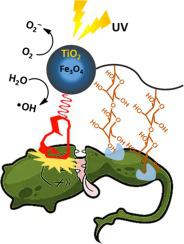当前位置:
X-MOL 学术
›
Eur. Polym. J.
›
论文详情
Our official English website, www.x-mol.net, welcomes your feedback! (Note: you will need to create a separate account there.)
Lactose-containing Glycopolymer Grafted onto Magnetic Titanium Dioxide Nanomaterials for Targeted Capture and Photocatalytic Killing of Pathogenic Bacteria
European Polymer Journal ( IF 6 ) Pub Date : 2021-01-01 , DOI: 10.1016/j.eurpolymj.2020.110159 Bingyu Wang , Cenyao Shang , Ziyue Miao , Shutong Guo , Qiang Zhang
European Polymer Journal ( IF 6 ) Pub Date : 2021-01-01 , DOI: 10.1016/j.eurpolymj.2020.110159 Bingyu Wang , Cenyao Shang , Ziyue Miao , Shutong Guo , Qiang Zhang

|
Abstract The superior photocatalysis of titanium dioxide (TiO2) had received much attention, but the effect of its separation and agglomeration on the water disinfection performance should not be ignored. Herein, lactose-containing glycopolymers grafted onto magnetic TiO2 nanomaterials were prepared through copper (0) mediated controlled radical polymerization and “grafting to” strategy to improve their separation and dispersibility properties. The physicochemical properties of the Fe3O4@TiO2/glycopolymers were systematically characterized by Fourier transform infrared spectroscopy, thermogravimetric analysis, dynamic light scattering, transition electron microscopy, and vibrating sample magnetometer. The result of the survival bacterial ratio under ultraviolet exhibited the well photocatalytic antibacterial activity of Fe3O4@TiO2/glycopolymers towards E. coli, which retained the photocatalytic sterilization performance of TiO2. Among them, Fe3O4@TiO2@poly(LacA) showed an excellent ability to identify and trap E. coli because of the carbohydrate-protein recognition effect. The endocytosis of E. coli on Fe3O4@TiO2@poly(LacA) was further confirmed by the image of transition electron microscopy. Considering the magnetic characteristics of Fe3O4@TiO2/glycopolymers, it is speculated that these antibacterial agents can be easily recovered by the external magnetic field, and thus be a promising candidate for photocatalysis water disinfection.
中文翻译:

含乳糖的糖聚合物接枝到磁性二氧化钛纳米材料上,用于靶向捕获和光催化杀灭病原菌
摘要 二氧化钛(TiO2)优异的光催化性能备受关注,但其分离和团聚对水体消毒性能的影响不容忽视。在此,通过铜 (0) 介导的受控自由基聚合和“接枝到”策略制备接枝到磁性 TiO2 纳米材料上的含乳糖糖聚合物,以改善其分离和分散性能。通过傅里叶变换红外光谱、热重分析、动态光散射、跃迁电子显微镜和振动样品磁强计系统地表征了 Fe3O4@TiO2/糖聚合物的理化性质。Fe3O4@TiO2/糖聚合物对大肠杆菌的光催化抗菌活性良好,紫外光下细菌存活率的结果保留了TiO2的光催化杀菌性能。其中,Fe3O4@TiO2@poly(LacA)由于碳水化合物-蛋白质识别作用而表现出优异的识别和捕获大肠杆菌的能力。过渡电子显微镜图像进一步证实了大肠杆菌对 Fe3O4@TiO2@poly(LacA) 的内吞作用。考虑到 Fe3O4@TiO2/糖聚合物的磁性,推测这些抗菌剂可以很容易地被外部磁场回收,因此是光催化水消毒的有希望的候选者。由于碳水化合物-蛋白质识别作用,Fe3O4@TiO2@poly(LacA) 表现出优异的识别和捕获大肠杆菌的能力。过渡电子显微镜图像进一步证实了大肠杆菌对 Fe3O4@TiO2@poly(LacA) 的内吞作用。考虑到 Fe3O4@TiO2/糖聚合物的磁性,推测这些抗菌剂可以很容易地被外部磁场回收,因此是光催化水消毒的有希望的候选者。由于碳水化合物-蛋白质识别作用,Fe3O4@TiO2@poly(LacA) 表现出优异的识别和捕获大肠杆菌的能力。过渡电子显微镜图像进一步证实了大肠杆菌对 Fe3O4@TiO2@poly(LacA) 的内吞作用。考虑到 Fe3O4@TiO2/糖聚合物的磁性,推测这些抗菌剂可以很容易地被外部磁场回收,因此是光催化水消毒的有希望的候选者。
更新日期:2021-01-01
中文翻译:

含乳糖的糖聚合物接枝到磁性二氧化钛纳米材料上,用于靶向捕获和光催化杀灭病原菌
摘要 二氧化钛(TiO2)优异的光催化性能备受关注,但其分离和团聚对水体消毒性能的影响不容忽视。在此,通过铜 (0) 介导的受控自由基聚合和“接枝到”策略制备接枝到磁性 TiO2 纳米材料上的含乳糖糖聚合物,以改善其分离和分散性能。通过傅里叶变换红外光谱、热重分析、动态光散射、跃迁电子显微镜和振动样品磁强计系统地表征了 Fe3O4@TiO2/糖聚合物的理化性质。Fe3O4@TiO2/糖聚合物对大肠杆菌的光催化抗菌活性良好,紫外光下细菌存活率的结果保留了TiO2的光催化杀菌性能。其中,Fe3O4@TiO2@poly(LacA)由于碳水化合物-蛋白质识别作用而表现出优异的识别和捕获大肠杆菌的能力。过渡电子显微镜图像进一步证实了大肠杆菌对 Fe3O4@TiO2@poly(LacA) 的内吞作用。考虑到 Fe3O4@TiO2/糖聚合物的磁性,推测这些抗菌剂可以很容易地被外部磁场回收,因此是光催化水消毒的有希望的候选者。由于碳水化合物-蛋白质识别作用,Fe3O4@TiO2@poly(LacA) 表现出优异的识别和捕获大肠杆菌的能力。过渡电子显微镜图像进一步证实了大肠杆菌对 Fe3O4@TiO2@poly(LacA) 的内吞作用。考虑到 Fe3O4@TiO2/糖聚合物的磁性,推测这些抗菌剂可以很容易地被外部磁场回收,因此是光催化水消毒的有希望的候选者。由于碳水化合物-蛋白质识别作用,Fe3O4@TiO2@poly(LacA) 表现出优异的识别和捕获大肠杆菌的能力。过渡电子显微镜图像进一步证实了大肠杆菌对 Fe3O4@TiO2@poly(LacA) 的内吞作用。考虑到 Fe3O4@TiO2/糖聚合物的磁性,推测这些抗菌剂可以很容易地被外部磁场回收,因此是光催化水消毒的有希望的候选者。



























 京公网安备 11010802027423号
京公网安备 11010802027423号